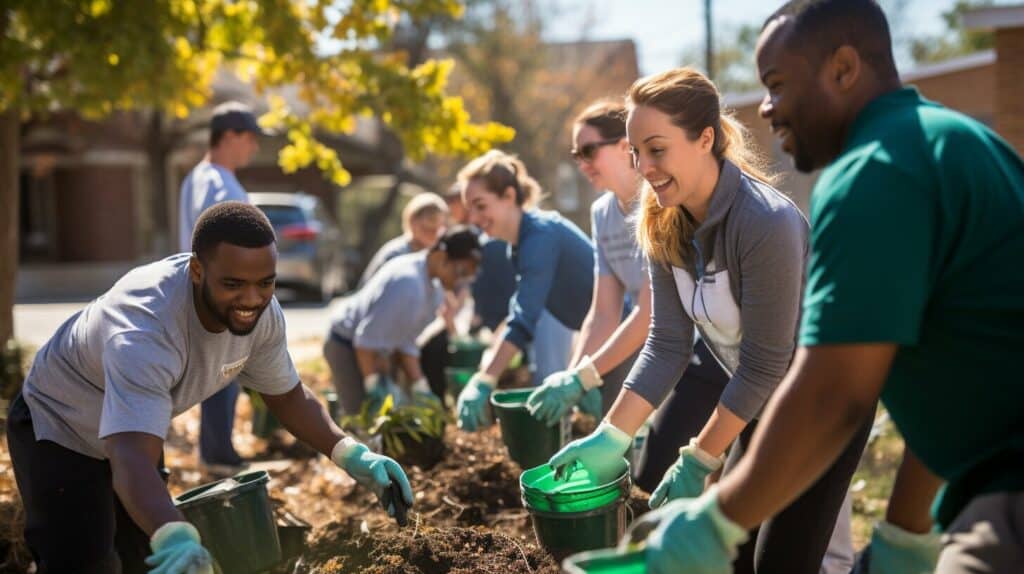As humans, one of our greatest joys is the act of giving. Giving can bring happiness, purpose, and fulfillment into our lives, and it can transform the world around us. In this section, we will explore the importance of giving and how it can enhance life and bring happiness to both the giver and the recipient.
Studies have shown that giving, whether through small acts of kindness or more enormous philanthropic efforts, can profoundly impact personal well-being and societal progress. Sharing can help us feel connected to others, increase our empathy, and provide a greater sense of purpose in life.
Moreover, giving back to our communities and those in need can create positivity far beyond the initial act of generosity. By practicing generosity and community service, we can strengthen our communities, inspire others to give, and foster a culture of giving and kindness.
Join us as we explore the transformative power of giving and the many ways in which it can enhance our lives and the world around us.
Understanding the Importance of Giving
At its core, giving is about acts of kindness and the transformative impact of philanthropy. It is also about social responsibility and fostering a culture of giving. By practicing giving, we benefit ourselves and contribute to the well-being of others and the wider community.
Small acts of kindness can create a ripple effect that spreads far beyond the initial recipient. Whether it’s offering a helping hand to a neighbor, volunteering at a local charity, or donating to a cause, every act of giving has the potential to make a difference.
| Impact of Philanthropy | Social Responsibility |
|---|---|
|
Philanthropy is one of the most impactful forms of giving. Whether it’s supporting a local nonprofit or making a donation to a global cause, philanthropy can create lasting change for individuals and communities in need. |
As members of society, we have a responsibility to give back and contribute to the greater good. By doing so, we create a more compassionate and connected world. |
Giving strengthens our communities and creates a sense of unity and purpose. Community service and volunteering are powerful ways to make a difference and build meaningful connections with others. Whether it’s cleaning up a local park, serving meals to the homeless, or mentoring a child, giving back to the community can be a fulfilling and enriching experience.
When we give for a cause, we can make a lasting impact on issues we care about. We can contribute to positive change and create a more just and equitable world by supporting organizations and initiatives that align with our values and passions.
Giving can also have a transformative effect on our own well-being. Research shows that generosity and acts of kindness can contribute to a sense of happiness, fulfillment, and purpose in life. By prioritizing giving, we can cultivate a more positive and meaningful existence.

Understanding the Importance of Giving
The power of giving extends far beyond the individual act itself. When we give, we inspire others to do the same, creating a chain reaction of kindness and generosity. By fostering a culture of giving, we can create a more compassionate and connected world, where acts of kindness are valued and celebrated.
The Benefits of Giving
Generosity is a powerful force that can transform both the giver and the recipient. Giving can lead to personal growth and create a sense of purpose that enhances one’s overall well-being. At the same time, giving can also strengthen communities and create a lasting impact when directed towards a cause.
Acts of giving can create positive emotions such as happiness and fulfillment. The act of giving can also serve as a reminder of the abundance in our lives, thereby increasing our gratitude and sense of contentment. Giving can help us connect with others, and when practiced within a community, it can foster a sense of belonging and camaraderie.
Community service is a form of giving that can be particularly rewarding. Volunteering time and resources can be an effective way to strengthen a community, connect with others, and gain perspective. Through volunteering and community service, individuals can develop skills, meet new people, and contribute to a larger cause.

Giving for a cause is another form of giving that creates a lasting impact. Whether it is directed towards a charitable organization, a community project, or a personal endeavor, giving for a cause can create significant change and improve the lives of others. It is a powerful way to contribute to the greater good, and can inspire others to do the same.
Giving and Personal Well-being
Aside from the positive impact that giving can have on others, it also has tremendous benefits for personal well-being. Studies have shown that those who practice generosity regularly experience increased levels of happiness and fulfillment.
When we give, we experience a sense of purpose and meaning. It allows us to connect with others on a deeper level, fostering a sense of community and belonging.
Generosity is not just limited to financial contributions. It can also include giving of our time, skills, and talents. Engaging in community service or volunteering can provide a sense of accomplishment and satisfaction and opportunities for personal growth and learning.

Furthermore, giving can have a positive impact on our physical health. Studies have shown that those who engage in acts of kindness and generosity have lower levels of stress and improved cardiovascular health.
Overall, giving can be a powerful tool for enhancing personal well-being and happiness. By incorporating acts of kindness and generosity into our daily lives, we can experience a greater sense of purpose and fulfillment and contribute to the well-being of those around us.
The Ripple Effect of Giving
When we give, we impact the lives of those who receive our kindness and create a ripple effect that can extend far beyond our immediate reach.
Acts of generosity can create a positive energy that spreads throughout our communities, inspiring others to give and fostering a culture of kindness and compassion.

This ripple effect can profoundly impact both the giver and the recipients. It can create a sense of connection, purpose, and fulfillment as we work together to create a better world.
The Ripple Effect of Giving: A Story
“I remember the day I decided to start giving back to my community. I was walking home from work and saw a man on the street asking for spare change. I didn’t have much, but I gave him what I could.
The next day, I saw the same man, and this time he thanked me for my kindness. He told me that he used the money to buy a meal and that it had made a huge difference in his day.
That moment stuck with me, and I started looking for more ways to give back. I volunteered at a local food bank, started donating to charities, and even started a fundraiser with my coworkers.
Since then, I’ve seen the ripple effect of my actions. My coworkers have started giving back too, and we’ve raised thousands of dollars for charity. It’s amazing to see how one small act of kindness can create such a big impact.”
This story demonstrates the power of the ripple effect and how one act of generosity can inspire and influence others to give.
By embracing a spirit of giving and generosity, we can create a world where kindness, compassion, and empathy are the norm.
Giving Back to the Community
One of the most fulfilling ways to give is by giving back to your community. Whether it’s through volunteering, community service, or supporting local initiatives, there are countless ways to make a positive impact in your area. By giving back, you not only contribute to the well-being of your community but also enhance your personal sense of purpose and fulfillment.
Volunteering is a great way to give back and connect with others in your community. Whether you choose to volunteer at a local charity, hospital, or school, your time and efforts can make a significant difference in the lives of others. By volunteering, you can also gain valuable skills, meet new people and expand your network.
Community service is another way to give back to your community. Participating in community service projects can help address local needs and improve the quality of life for those around you. Whether it’s cleaning up a park, feeding the homeless, or assisting with disaster relief efforts, community service can be a meaningful way to make a positive impact.
Supporting local initiatives is also a powerful way to give back to your community. Whether it’s donating to a local food bank, supporting a community event, or contributing to a local charity, your support can make a significant difference. By supporting local initiatives, you can help strengthen your community and foster a sense of connection and belonging.
Remember, giving back to your community doesn’t have to be a grand gesture. Even small acts of kindness can make a meaningful impact. Consider picking up litter in your community, helping a neighbor with their yard work, or simply smiling and greeting others as you go about your day.

By giving back to your community, you not only enhance the lives of others but also enrich your own life. Through volunteering, community service, and supporting local initiatives, you can make a positive impact and contribute to a more vibrant, connected, and thriving community.
Cultivating a Culture of Giving
Giving is not just about individual acts of kindness; it is about creating a culture of generosity and compassion.
Leading by Example
Leading by example is one of the best ways to cultivate a culture of giving. By modeling generosity and kindness, we inspire others to do the same. Small acts of kindness can have a ripple effect that extends far beyond their immediate impact.
Whether it is buying a cup of coffee for a stranger or volunteering at a local soup kitchen, every act of giving counts. By making generosity a habit, we can help create a culture of giving that benefits everyone.
Teaching Children to Give
One of the most effective ways to cultivate a culture of giving is by teaching children to give. By instilling the value of kindness and generosity in our children, we can help create a future generation that prioritizes giving and compassion.
Encourage your children to share their toys, to donate their allowance to a charity, and to volunteer their time to help others. These small acts of kindness can help instill a sense of empathy and compassion in our children that will stay with them for a lifetime.
Fostering an Environment that Encourages Giving
Creating a culture of giving is not just about individual acts of kindness or teaching children to give. It is also about fostering an environment that encourages and celebrates giving.
This can mean supporting local charities and initiatives, recognizing individuals and organizations that prioritize giving, and integrating giving into our daily lives. By making giving a part of our community and culture, we can create a society that values kindness, empathy, and generosity.

“No one has ever become poor by giving.” – Anne Frank
Giving is not just about helping others but also helping ourselves. By cultivating a culture of giving, we can create a society that is happier, healthier, and more fulfilled. So let’s start giving today and make the world a better place, one act of kindness at a time.
The Importance of Overcoming Barriers to Giving
In our busy lives, it can be easy to put charitable giving on the back burner. However, with a little effort and creativity, it’s possible to prioritize giving and make a significant impact. Here are some common barriers to giving and tips for overcoming them:
Financial Constraints
One of the most common barriers to giving is financial constraints. However, giving doesn’t have to break the bank. Consider setting a budget for charitable giving, even if it’s a small amount. You can also look for ways to give that don’t involve monetary donations, such as volunteering or donating goods and services.
Another strategy is to donate a portion of your income or assets to a cause you care about. This can be done through planned giving, which allows you to make a charitable donation while also receiving tax benefits.
Time Constraints
Another common barrier to giving is time constraints. With busy work schedules and family obligations, it can be difficult to find the time to volunteer or participate in community service. However, there are ways to give back that fit into even the busiest of schedules.
Consider participating in a virtual fundraiser or donating goods and services online. You can also look for volunteer opportunities that are flexible and can be done on your own time, such as mentoring or tutoring programs.
Lack of Awareness
Many people want to give back but may not be aware of the opportunities available to them. To overcome this barrier, take some time to research charities and community organizations that align with your values and interests.
You can also talk to friends and family members about their giving experiences and ask for recommendations. Additionally, consider following charities and nonprofits on social media to stay up-to-date on their activities and events.
Remember that even small acts of giving can make a big impact. We can prioritize charitable giving by overcoming these barriers and create positive change in our communities and the world.

Frequently Asked Questions about the Importance of Giving
Giving can be an enriching experience, but it can also be confusing and overwhelming at times. We’ve compiled a list of some common questions related to charitable giving, community service, and philanthropy to help answer any queries you may have.
How much should I give to charity?
There is no specific amount that you should give to charity, as it ultimately depends on your personal financial situation and charitable goals. Many people choose to give a percentage of their income, such as 1% or 5%, while others prefer to give a specific amount each year. It’s important to choose a giving level that is sustainable for you and aligns with your values and goals.
How can I ensure that my donation is being used effectively?
Researching the charity you plan to donate to is key to ensuring that your donation is being used effectively. Look for charities that have a strong track record of impact and transparency in their financial reporting. You can also consult third-party websites, such as Charity Navigator or GuideStar, for information and ratings on various charities.
How can I get involved in community service?
There are countless ways to get involved in community service, ranging from volunteering at a local organization to organizing a neighborhood clean-up. Start by identifying causes or issues that you’re passionate about and look for local organizations that align with your interests. You can also reach out to your school, workplace, or place of worship to find volunteer opportunities.
How can I teach my children about the importance of giving?
Leading by example is one of the most effective ways to teach children about the importance of giving. Involve your children in your own charitable efforts and encourage them to participate in age-appropriate volunteer activities. You can also use everyday moments, such as when your child receives a gift, to talk about the importance of expressing gratitude and giving back to others.
Can I deduct charitable donations on my taxes?
Yes, you can typically deduct charitable donations on your taxes if you itemize your deductions. However, there are certain criteria and limitations to be aware of, such as the charity must be a qualified tax-exempt organization and you must have proper documentation of your donation. Consult a tax professional or refer to IRS guidelines for more information.
How can I make giving a regular part of my life?
Making a conscious effort to prioritize giving is key to making it a regular part of your life. Start by identifying causes or organizations that align with your values and create a giving plan that fits within your budget. You can also set reminders or schedule recurring donations to help keep giving top of mind. Remember that even small acts of kindness and generosity can make a significant impact.





Leave a Reply